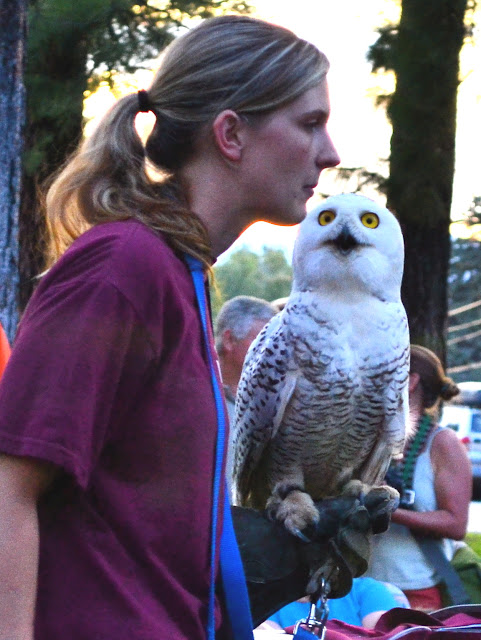Wednesday, August 8, 2012
Rapt for raptors
Last night (Aug. 7) Frank and I and perhaps 200 other folks enjoyed the Methow Conservancy's First Tuesday program on a warm evening in Winthrop's Mack Lloyd Park.
Jessica Graham from Washington State University's Raptor Club brought three beautiful live raptors all the way to Winthrop from Pullman (about 5 hours' drive away) in order to educate, entertain, and help people develop an interest in these magnificent birds.
Raptors are birds that "think with their feet," said Graham. They are birds of prey - owls, hawks, falcons and eagles - that rely on their talons to survive.
Graham brought three birds with her for the program: an American kestrel, a northern harrier, and a snowy owl.
Any bird that remains in residence at the WSU Raptor Club is there because it cannot be rehabilitated back to the wild, generally because it cannot fly, Graham said.
"We are an educational club, not a rehabilitation group," said Graham. Birds that may be rehabilitated would go to an organization that specializes in that work.
The club has 16 resident birds of a variety of species, and many of them travel for presentations to groups like ours.
"Some of our birds will ham it up a little," Graham said. "They love having their pictures taken."
The first and smallest bird - about the size of a robin - that came out of its carrier was Everett, a male American kestrel.
Everett's beautiful blue/gray, white and russet markings are the hallmarks of the male kestrel, who "tend to be a little prettier than the females," Graham said. Kestrels are a sexually dimorphic species, which means that the males and females look different. In some other bird species only a DNA test can verify an individual's gender.
Micah, the two-year-old northern harrier, was out next.
Micah's left wing had been amputated because when he was around six weeks old he was hit by a wheat farmer's combine. Harriers are a ground nesting species, so babies like Micah - who hadn't fledged from the nest yet - are especially vulnerable to farm accidents, Graham said.
Finally we met the largest bird of the evening: Tundra, a 3-pound snowy owl.
Tundra was new to the club, having arrived in the Spokane area with a dislocated shoulder during last winter's irruption of snowy owls. Although normally an arctic species, snowy owls will "irrupt" in certain years; many were spotted around Washington state and locations farther south last winter.
The WSU Raptor Club has 50-75 members who actively work with the birds, Graham said.
The captive birds have considerably longer lifespans than they would in the wild. Because they can't fly, they are fed mice and quail, freshly killed by the club members.
Though the birds have it pretty good, Graham thinks they don't really like their handlers. "These guys tolerate us," she said. "Some birds prefer some people over others."
Subscribe to:
Post Comments (Atom)




No comments:
Post a Comment